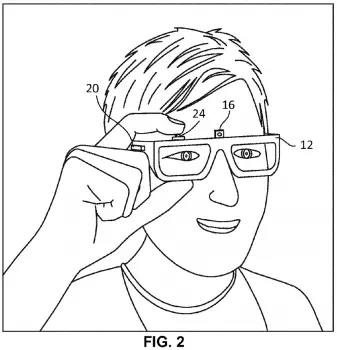
This is what Google Glass looked like back in 2011 (and what it could eventually become)
Just as CES is beginning to wind down, we’ve happened upon another interesting patent put forth by Google. As you know, a product or idea in its infancy might not look like the unit that’s eventually launched to retail. They undergo countless changes and refinements until everyone’s happy with what they’ve cooked up. We imagine the same happened for Google Glass.
This patent — originally filed back in 2011 but published in recent days — shows an eyeglass apparatus that includes an onboard camera, as well as a physical shutter button that can be used to snap a photo of whatever’s in front of you. The main illustration Google used to explain their patent is perhaps one of the oddest things we’ve ever seen:
You could call it a natural combination of GoPro-style video capturing equipment and, for the very people that would need a GoPro, safety goggles (Google refers to goggles as a potential category of eyewear that this design could be used for).
But it’s this idea that may have been the original basis for what we now know as Google Glass. The patent’s description goes on to describe a system where the camera could be used in conjunction with a head-mounted display (such as the one present on Google Glass) to facilitate the use of augmented reality applications and general photo and video capturing.
Even more interesting than how the camera is fitted, though, is how Google envisioned displaying information to the user. Figure 4 inside the patent document shows a device that would be able to project information like notifications, time, battery life and more directly on not just one lens, but both.
This is in contrast to the current implementation which uses a single capsule that protrudes from the main frame element and holds all the computing guts, which in turn mounts a separate display for projecting information onto. The patent goes on to detail things like cellular and wireless connectivity, touchpads for manipulating a user interface and more — some of those features have already been implemented in the current iteration of Google Glass.
So why is it only just now surfacing? It could be because Google is getting ready to use some of these ideas in a forthcoming revision of Glass not yet seen by the public. A recent report from the Wall Street Journal suggests Google will introduce a major new version of the smart glasses with an entirely new set of silicon for the product’s retail release, likely powered by Intel.
A source familiar with the matter also tells Phandroid that Google has been internally testing a new model of Google Glass that look more like traditional frames than the Star Trek-like eye guards Levar Burton would’ve been proud to wear. We’ve already seen them go that route with a stylish line of frames that you can mount Glass to, but perhaps they’re looking to make that the standard kit and caboodle once it hits retail.
Whatever the case may be, we wouldn’t be surprised to learn that Google wants to make Glass more appealing to your everyday Joe Schmo by introducing a radical change in design (especially since a lot of people seem to be doubting their ability to thrust it into the mainstream limelight in its current form). Would you buy Google Glass if they managed to come up with a less awkward design?